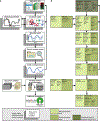Best Practices for Making Reproducible Biochemical Models
- PMID: 32853539
- PMCID: PMC7480321
- DOI: 10.1016/j.cels.2020.06.012
Best Practices for Making Reproducible Biochemical Models
Abstract
Like many scientific disciplines, dynamical biochemical modeling is hindered by irreproducible results. This limits the utility of biochemical models by making them difficult to understand, trust, or reuse. We comprehensively list the best practices that biochemical modelers should follow to build reproducible biochemical model artifacts-all data, model descriptions, and custom software used by the model-that can be understood and reused. The best practices provide advice for all steps of a typical biochemical modeling workflow in which a modeler collects data; constructs, trains, simulates, and validates the model; uses the predictions of a model to advance knowledge; and publicly shares the model artifacts. The best practices emphasize the benefits obtained by using standard tools and formats and provides guidance to modelers who do not or cannot use standards in some stages of their modeling workflow. Adoption of these best practices will enhance the ability of researchers to reproduce, understand, and reuse biochemical models.
Keywords: COmputational Modeling in BIology NEtwork; FAIR principles; biochemical models; modeling; reproducibility; standards; systems biology.
Copyright © 2020 Elsevier Inc. All rights reserved.
Figures

References
-
- Ashyraliyev M, Fomekong-Nanfack Y, Kaandorp JA, and Blom JG (2009). Systems biology: parameter estimation for biochemical models. FEBS Journal 276, 886–902. - PubMed
-
- American Journal of Political Science (AJPS). (2016). American journal of political science qualitative data verification checklist. https://ajps.org/wp-content/uploads/2019/01/ajps-qualdata-checklist-ver-....
-
- Brazma A, Hingamp P, Quackenbush J, Sherlock G, Spellman P, Stoeckert C, Aach J, Ansorge W, Ball CA, Causton HC, et al. (2001). Minimum information about a microarray experiment (MIAME)- toward standards for microarray data. Nat. Genet. 29, 365–371. - PubMed
Publication types
MeSH terms
Grants and funding
LinkOut - more resources
Full Text Sources

